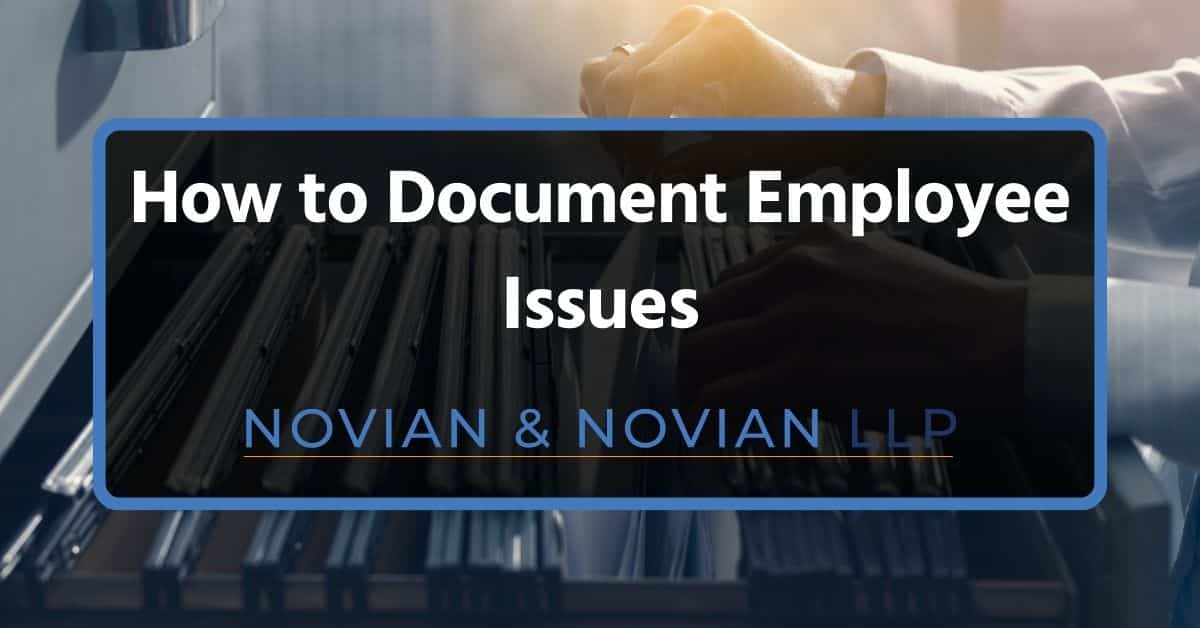
by | Nov 24, 2023 | Employee Issues
It isn’t uncommon for employee issues to arise in any organization. What matters is that you treat these issues with the utmost professionalism and empathy to maintain a harmonious workplace as well as how you chose to document those issues.
When done correctly, documentation protects you as the employer if any legal issue arises helps nurture a workplace where employees flourish and contribute their best.
We are a team of professionals who understand the balance between legal compliance, ethical considerations, and effective managerial strategies.
In this article, we’ll be sharing valuable insights on documenting employee behavior with a focus on fostering positive workplace dynamics and ensuring best practices that will hold up in court.
Perspectives to Employee Documentation
Legal Perspective to Performance Documentation
When it comes to employment law, documentation stands as a safeguard for both employers and employees. Legal compliance requires meticulous records of employee performance, behavior, conduct, etc.
By carrying out performance documentation, you’re adhering to labor laws and also building a employer defense case for legal purposes if needed.
Managerial Perspective to Employee Documentation
From a managerial angle, thorough documentation is necessary for fairness and consistency. Through performance documentation, managers can track performance records, identify rooms for growth, and make informed decisions.
As an employer, documenting records helps to create a positive and enabling organization’s culture. It also builds trust and open communication between employees and management
Understanding the Need for Documentation
Documenting employee performance issues is important for any organization. It provides a clear record of things, improves communication between employees and management, etc.
The key to documenting employee behavior is to see it as a tool for improvement and resolution, not as a punitive measure. Let’s unveil some benefits documentation brings for a company:
Encourages Fairness and Consistency
By documenting employee performance, policies, behaviors, and procedures, employers and organizations take a stand for fairness and consistency. It fosters a sense of unity amongst employees as they are poised to treat everyone equitably.
Creates a Clear Historical Record
Documentation stands as the memory card or flash drive for any company. Through performance record, a manager can trace an employee’s journey within the company. It aids in performance review and evaluations, promotions, and even strategic decision-making.
Streamlines Communication
It is always important to build an open and effective communication system within your company; you can do this through documentation. With documentation, managers can convey their clear expectations, give, and also receive feedback.
Navigates Employee Relations and Conflict Resolution
Documentation is a tool for resolution when employee performance issues arise. By documenting employee’s behavior, you have clear records of incidents and discussions.
It helps managers to identify patterns, make informed decisions, and maintain fairness. It can also protect the organization when legal matters arise.
Builds Trust
When employees see that what they do is recorded, it fosters a positive working environment and clear expectations. It encourages them to do better at their work and brings about job satisfaction.
What Issues Require Documentation?
Documentation is a valuable tool for managing a variety of issues. Some common types of issues to document as an employee include:
- Performance issues: This includes employee’s performance, failure to meet performance expectations, missed deadlines, low work quality, inconsistency, etc.
- Behavioral concerns: This includes unprofessional conduct, insubordination, violation of company policies, etc.
- Ethical violations
- Health and safety concerns
- Employee development needs
- Conflict and disputes
- Change in job responsibilities
- Positive recognition and achievements
While this is not an exhaustive list, documenting these issues provides a written record that can always be referenced. It ensures fairness, consistency, and transparency.
Effective Documentation Techniques
Now that you have a clear picture of documenting employee issues, let’s see how to get it done. Some effective documentation techniques include:
Use Clear and Concise Language
Clarity is important and necessary for any employee performance documentation process. Make sure to avoid jargon or ambiguous terms while preparing the records.
It is also important to stick to objective statements rather than subjective opinions. This approach makes employees feel less judged as it comes as positive feedback.
Be Well Detailed and Format Your Document Well
During employee performance documentation, you should keep records in a way that anyone can understand when they pick it up. It should also include dates, times, and all relevant details.
It is best to keep documentation of employee behavior chronological to provide a timeline of events and actions. This way, it is easy and fast to identify patterns or areas that may require additional attention.
Pro tip: make sure that dates are mentioned in the titles of your document.
Give Positive and Constructive Feedback
Employee performance documentation is not only about address employee problems or poor performance. It should also contain their positive contributions and achievements.
It is good for the document to have a balance of positive and constructive feedback. It gives a fair assessment of an employee’s overall performance. It can also include how to reward employees.
Implement the Use of Technology
Leveraging technology helps in getting the work done easier and faster.
You can leverage technology like document management systems to file records. This enhances accessibility and collaboration amongst team members involved in the documentation process.
Pro tip: You can utilize various note takers or transcription tools.
Seek Legal Guidance
When it seems like the employee issue is getting out of hand, you should seek legal guidance. Our 35 years of delivering first-tier legal services have shown that having detailed documentation of employee issues helps you win the case before it even starts.
Involving the Employee
While you document and have your records, it is also important to involve the employee.
Encourage employees to participate in the documentation process. Let them have records of their achievements, goals, and even challenges. When employees join the documentation journey and have their personal records, you can see things from their perspective.
Some way to involve employees include:
Have an Open Communication System
It is necessary to create an open communication system with employees as it sets the pace for a positive work environment. Clearly communicate to them that the purpose of documenting employee behavior is for growth and improvement, not as a punishment.
By doing this, they are positively encouraged and are ready to engage in collaborative initiatives.
Co-create Performance Goals
By co-creating performance goals with employees, you’re ensuring there is a shared understanding of expectations. It gives them the push to be more committed towards the goals of the organization.
Conduct Regular Check-Ins
You can only know how your employees feel when you check-in on them. Thus, it is helpful to foster a culture of continuous feedback through check-ins.
You can discuss progress and address concerns on the job. It also contributes to a more responsive documentation process.
Acknowledge Achievements and Contributions
Recognizing and celebrating employee achievements, whether big or small, is important, and should be included in employee performance documentation. It reinforces a culture of appreciation and motivates employees to continue their efforts.
Provide Training and Resources
Encourage employees to take ownership of their professional development by actively participating in performance documentation. It instills in them a proactive mindset necessary for the job.
Offer training and resources to help employees understand the documentation process. By equipping employees with necessary skills, you ensure their meaningful participation in documenting employee performance, and also improves their work process.
Conclusion
Employee performance documentation is both an art and a science. It is an essential skill employers must have for fostering a positive and productive workplace that is legally adherent.
You should approach documentation with a focus on resolution and maintaining confidentiality. Contact us now for legal guidance on proper documentation that will hold up in court.
When you are dealing with a legal issue, it is crucial to rely on a team that has established a strong track record of success. Founded in 1988, our firm has been helping clients achieve their legal objectives for more than 30 years. Throughout that time, our highly experienced lawyers have placed a strong focus on quality service leading to efficient resolution of our clients’ legal issues.
Contact Us
Have questions about this post? Novian & Novian is a full service law firm in Los Angeles with clients that span the country. Contact us today for a free consultation.
Contact Us
Have questions about this post? Novian & Novian is a full service law firm in Los Angeles with clients that span the country. Contact us today for a free consultation.




